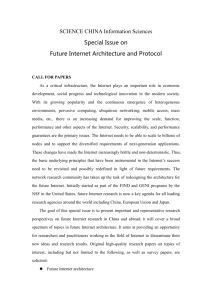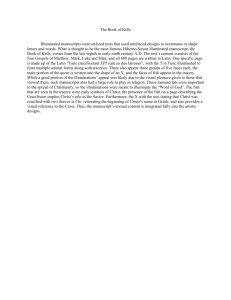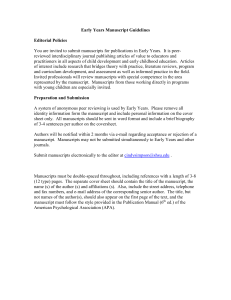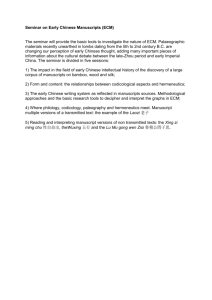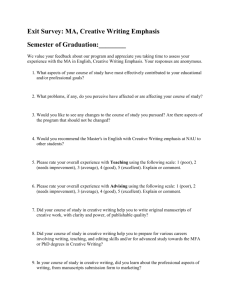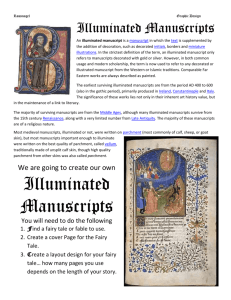History of Art and Visual Culture 153: History of the Book
advertisement
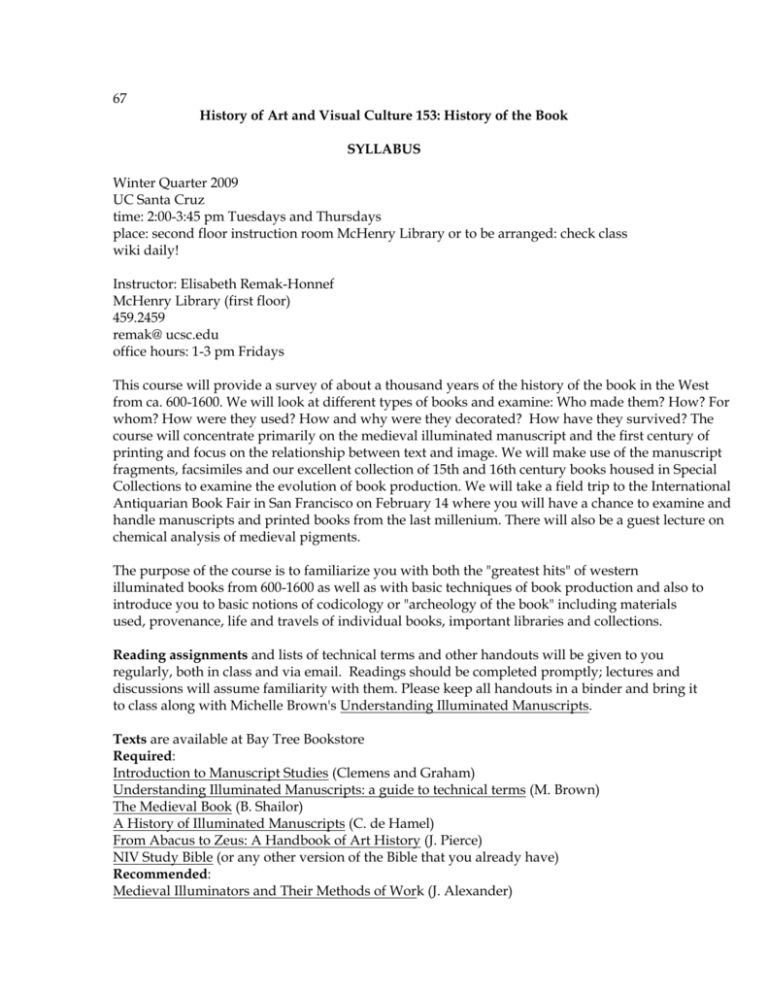
67 History of Art and Visual Culture 153: History of the Book SYLLABUS Winter Quarter 2009 UC Santa Cruz time: 2:00-3:45 pm Tuesdays and Thursdays place: second floor instruction room McHenry Library or to be arranged: check class wiki daily! Instructor: Elisabeth Remak-Honnef McHenry Library (first floor) 459.2459 remak@ ucsc.edu office hours: 1-3 pm Fridays This course will provide a survey of about a thousand years of the history of the book in the West from ca. 600-1600. We will look at different types of books and examine: Who made them? How? For whom? How were they used? How and why were they decorated? How have they survived? The course will concentrate primarily on the medieval illuminated manuscript and the first century of printing and focus on the relationship between text and image. We will make use of the manuscript fragments, facsimiles and our excellent collection of 15th and 16th century books housed in Special Collections to examine the evolution of book production. We will take a field trip to the International Antiquarian Book Fair in San Francisco on February 14 where you will have a chance to examine and handle manuscripts and printed books from the last millenium. There will also be a guest lecture on chemical analysis of medieval pigments. The purpose of the course is to familiarize you with both the "greatest hits" of western illuminated books from 600-1600 as well as with basic techniques of book production and also to introduce you to basic notions of codicology or "archeology of the book" including materials used, provenance, life and travels of individual books, important libraries and collections. Reading assignments and lists of technical terms and other handouts will be given to you regularly, both in class and via email. Readings should be completed promptly; lectures and discussions will assume familiarity with them. Please keep all handouts in a binder and bring it to class along with Michelle Brown's Understanding Illuminated Manuscripts. Texts are available at Bay Tree Bookstore Required: Introduction to Manuscript Studies (Clemens and Graham) Understanding Illuminated Manuscripts: a guide to technical terms (M. Brown) The Medieval Book (B. Shailor) A History of Illuminated Manuscripts (C. de Hamel) From Abacus to Zeus: A Handbook of Art History (J. Pierce) NIV Study Bible (or any other version of the Bible that you already have) Recommended: Medieval Illuminators and Their Methods of Work (J. Alexander) British Library Guide to Manuscript Illumination: History and Techniques (C. de Hamel) or Scribes and Illuminators (C. de Hamel) Reserve Readings at McHenry: see handout -- please make use of these books. Handouts: You will receive a packet today -- please bring it to class regularly. Evaluation and Grading will be based on: class participation, 2 short Special Collections assignments, one short in-class presentation, one manuscript description, one printed book description, and one exhibit project. The exhibit will be installed in McHenry Library during the last week of the quarter and your work will be on display during the spring of 2007. Class members will work in groups of five to prepare cases. We will choose the topic of the exhibit together. You must be present on the day of the final exam (March 19, 7:30-10:30pm) to install the exhibit which takes the place of a final exam. There will be quizzes if I think that you are not keeping up on the reading. Important dates: January 8: pick up Lindisfarne assignment in Special Collections January 15: Lindisfarne assignment due January 15: pick up Lorsch assignment in Special Collections; choice for ms project due January 22: Lorsch assignment due February 14: field trip to International Antiquarian Book Fair in San Francisco February 19: Manuscript description due; choice for printed book project due March 5: printed book description due March 19: installation of class exhibit from 7:30-10:30pm. Lecture schedule (rough outline): Week 1 (January 6, 8 –nota bene: January 9 in Special Collections) Introduction Late Antique and Early Christian books Read: De Hamel introduction, pp 8-13; Richard Clemens web essay on medieval book production; Bible reading: Book of Genesis Week 2 (January 13, 15) Insular manuscripts; introduction to codicology Books for missionaries Read: Clemens & Graham chapters 1 and 2, De Hamel chapter 1; Bible: one of the gospels (either Matthew, Mark, Luke or John) Week 3 (January 20, 22) Carolingian manuscripts; introduction to paleography Books for emperors Read: Clemens chapters 5 and 6, De Hamel chapter 2. Start reading Clemens chapter 10 Week 4 (January 27, 29 – nota bene: January 29 in Special Collections) Ottonian manuscripts; more codicology Books for emperors Read: Clemens chapters 3, 4 and 8; De Hamel chapter 2; Bible: Book of Psalms Week 5 (February 3, 5) Romanesque manuscripts; more codicology Books for monks Read: Clemens chapters 7, 9 and finish chapter 10; De Hamel chapter 3; Bible: Book of Psalms Weeks 6 and 7 (February 10, 12, 17, 19) Gothic manuscripts; liturgical calendar; liturgical and secular books Books for students; Books for priests; Books for aristocrats Trip to International Antiquarian Book Fair in San Francisco on February 14 Read: Clemens chapter 11, De Hamel chapters 4 and 7 (week 6) Read: Clemens chapter 12, De Hamel chapter 5; Bible: Apocalypse (week 7) Week 8 (February 24, 26) Humanist books Books for everybody; Books for collectors Read: Clemens chapters 13 and 15, De Hamel chapters 6 and 8 Weeks 9 and 10 (March 3, 5, 10, 12) Early printed books and exhibit preparation Final Project: Exhibit Installation March 19 7:30-10:30 pm: attendance mandatory

